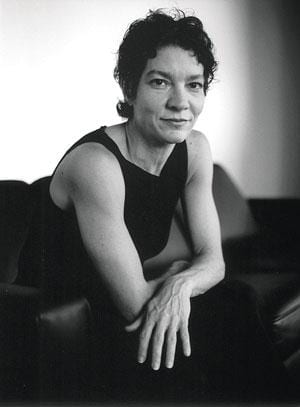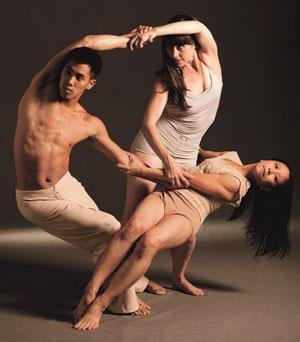
Credit: Kenneth Gray
Julia Sasso sits intently in the basement of the Toronto Dance Theatre on Winchester Street, back straight, Tim Hortons coffee sweetened with stevia in hand. Her bare feet — bumpy, rough, calloused — are planted firmly on the floor. They provide a road map of her provocative dance career and call to mind a Neruda poem:
When I cannot look at your face/I look at your feet/Your feet of arched bone/your hard little feet . . . /I love your feet/only because they walked/upon the earth and upon/the wind and upon the waters/until they found me.
Sasso is watching her ensemble rehearse, teasing out the details, carefully examining the bodies she has chosen to help her tell a beautiful story. “Sue,” she says to one of her dancers, “touch Irvin’s face.” Sue fixes her gaze on Irvin’s face and touches it with firm tenderness. Sasso cocks her head to evaluate the emotional quality of the gesture. It pleases her. She nods.
Sasso’s latest piece is called SLoE (Simple Lines of Enquiry) and is based on a composition of the same name by the late Ann Southam. The piece explores the big stuff with the delicate reserve the title suggests.
“Life and death,” Sasso says. “Why? How come? When? What if? What comes after? Why do we do the things we do to each other?” These were all things, she says, that Southam was contemplating when she composed this work, which has the quiet, meditative quality of Brian Eno’s Music for Airports, with a more affectionate touch. (Dare I say female? Southam was a huge supporter of what she called “femaleness,” and her work often reflects the repetitive quality of “women’s work.”)
Southam made this piece late in her life and it is introspective and retrospective. There is a profound kindness to it, and Sasso gets at this by creating a tremendous sense of support, both visually in the piece and in the process. The dancers are unanimous in their sense of compassionate community. The burden of movement is supported by each dancer, and the grace of the movement comes from seeing the effort, rather than hiding it. As the notes dissolve in the music, so does the movement, dancers going forward with intention, their movement evaporating and being taken up by another. Throughout the piece there is a recurrent suggestion that we look for ourselves and our life experiences in other people.
Southam made Simple Lines of Enquiry for Eve Egoyan to play, and Egoyan will play it in this production —upstage right, with a full-sized concert grand.
Sasso talks about the support Southam and Egoyan showed for one another, “elevating each other’s careers though trust and generosity.” In 2008, Southam presented the piece to Sasso and commissioned her to make a solo for it, which Sasso did, but then realized she wanted to be outside of it as a choreographer.
Southam agreed with her choice, which reflects the purpose of the work, and the theme of support that has been at its inception. Sasso takes all the notes she made with her own body and brings a variety of dancers at different points in their careers (five women, one man) to reflect this “metaphor for a life journey.”

 Why you can trust Xtra
Why you can trust Xtra


